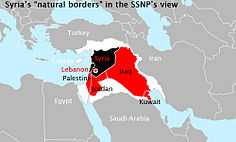Greater Syria

Part of a series on the |
|---|
| History of Syria |
 |
| Prehistory |
| Bronze Age |
| Antiquity |
|
| Middle Ages |
|
| Early modern |
| Modern |
|
| Timeline |
| Syria portal |
Greater Syria (Arabic: سوريّة الكبرى) or Natural Syria (Arabic: سوريّة الطبيعية), Bilad ash-Sham (Arabic: بلاد الشام) is a hypothetical united Fertile Crescent state.[1] The term denotes the restoration of the Arab Kingdom of Syria. The proclaimed area extends roughly over the medieval Arab Caliphate province of Bilad al-Sham, encompassing the Eastern Mediterranean or the Levant and Western Mesopotamia at the peak glory of the Arab Muslim civilization.
The pre-Islamic, Hellenistic name of the region, "Syria", was used by the Ottomans in the Syria Vilayet until the collapse of the Ottoman Empire in 1918. The wave of Arab nationalism in the region evolved towards the creation of a new "Great Syria" over French-governed Occupied Enemy Territory Administration, declared as Hashemite Kingdom on March 1920, claiming extent over the entire Levant. Following the Franco-Syrian War, in July 1920, French armies defeated the newly proclaimed Arab Kingdom of Syria and captured Damascus, aborting the Arab state. The area was consequently partitioned under French and British Mandates into Greater Lebanon, various Syrian states, Mandatory Palestine and Transjordan. The Syrian states were gradually unified as the State of Syria and finally became the independent Republic of Syria in 1946.
Historic background
In the most common historical sense, Syria refers to the entire northern Levant, including Alexandretta and the ancient city of Antioch, (the pre-Islamic capital of Syria), or in an extended sense the entire Levant as far south as Egypt, but not including Mesopotamia.
The origin of the Hellenistic term Syria is linked in the etymology of the Neo-Assyrian Empire, so a "Greater Syria" in this sense corresponds to "Greater Assyria", which includes all of the Levant and Mesopotamia.
The uncertainty in the definition of the extent of "Syria" is aggravated with the etymological confusion of the similar-sounding names Syria and Assyria. The question of the ultimate etymological identity of the two names remains open today, but regardless of etymology, the two names have often been taken as exchangeable or synonym from the time of Herodotus.[2] In the Roman Empire Syria and Assyria already referred to two separate entities, Roman Syria and Roman Assyria).

Arab conquest of the Levant in the 7th century gave rise to the Bilad al-Sham province, which functioned under the Caliphates. The province was encompassing much of the region of Syria and became largely overlapping with this concept.
Pan-Syrian nationalism and Proposals for Unification
In the nationalist ideology developed by the founder of the Syrian Social Nationalist Party, Antun Saadeh, Syria is seen as the geocultural environment in which the Syrian nation state evolved, an area Sa'adeh called the Syrian Fertile Crescent.
Sa'adah rejected both language and religion as defining characteristics of a nation, and instead argued that nations develop through the common development of a people inhabiting a specific geographical region. He pointed to what he considered to be the region's distinct natural boundaries, and described it as extending from the Taurus range in the northwest and the Zagros Mountains in the northeast, to the Suez Canal and the Red Sea -including the Sinai Peninsula and the Gulf of Aqaba in the south, and from the eastern Mediterranean Sea including the island of Cyprus in the west, to the arch of the Arabian Desert and the Persian Gulf in the east.
In the 1940s, Britain secretly reversed from their position supporting the British-issued Balfour Declaration, instead advocating the creation of a Greater Syrian state that would secure Britain preferential status in military, economic and cultural matters, in return for putting a complete halt to Jewish ambition in Palestine. France and the United States opposed British hegemony in the region, which lent support to the creation of modern Israel.[3]
Abdullah I of Jordan had been a proponent of Greater Syria under Hashemite rule, based on the original proposal for a Kingdom of Syria following the Arab Revolt. The Hashemite monarchy of Iraq was also believed to have harboured ambitions of union with Syria. The Ba'athist government of Hafez al-Assad in Syria also pursued the idea of Greater Syria, resulting in its involvement in the Lebanese Civil War and the Syrian Occupation of Lebanon.
See also
References
- ↑ (Arabic) نشوء الأمم ، أنطون سعادة دار الركن
- ↑ Herodotus. "Herodotus VII.63".
VII.63: The Assyrians went to war with helmets upon their heads made of brass, and plaited in a strange fashion which is not easy to describe. They carried shields, lances, and daggers very like the Egyptian; but in addition they had wooden clubs knotted with iron, and linen corselets. This people, whom the Hellenes call Syrians, are called Assyrians by the barbarians. The Chaldeans served in their ranks, and they had for commander Otaspes, the son of Artachaeus.
- ↑ Britain’s treachery, France’s revenge
Further reading
- Pipes, Daniel (1990). Greater Syria: the History of an Ambition. New York: Oxford University Press. viii, 240 p., ill. with b&w photos and maps. ISBN 0-19-506002-9 pbk.; alternative ISBN on back cover, 0-19-506002-4
Sources
- Article "Al-Sham" in the Encyclopedia of Islam by C.E. Bosworth, volume 9, p. 261 (1997).
- Dictionary of Modern Written Arabic by Hans Wehr (4th edition, 1994).
| ||||||||||||||||||||||
| ||||||||||||||||||||||||||||||||||||||||||||||||||||||||